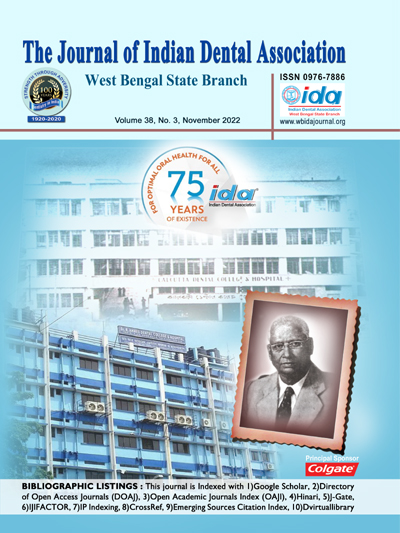Upcoming Events
1. Article Title.
2. Author Details.
3. Abstract.
4. Keywords.
5. Corresponding Author details.
November 2022
Volume : 38
No.: 3

Dr. Rajesh Khan,Dr. Ashish Kumar Barui,Dr. Kritika Rajan,Dr. Nilankush Das
Abstract: The primary focus of present day dentistry lies on preservation of remaining natural teeth. Transitional denture is an alternative treatment plan for those patients who are willing to replace their missing teeth while retaining their few natural teeth. A relatively newer type of transitional denture is Cu-sil denture. A Cu-sil denture is a simple removable partial denture with holes, lined by a gasket of silicone rubber, the holes thus providing space for remaining natural teeth to emerge into the oral cavity through the denture. This case report describes the fabrication of Cu-sil denture using soft liners in usual dental set up.
Dr. Nirmalya Chatterjee,Dr. Amrita Ghosh
Abstract: Magnetic Resonance Imaging(MRI) is a non invasive imaging procedure for hard and soft tissue lesions. It is very useful for patients with seizures, tumours, Temporomandibular jointdisorders and Cerebrovascular accidents. However in patients with pacemaker, neurostimulator, fixed metal prosthesis Magnetic Resonance Imaging is contraindicated as these devices may be dislocated or soft tissue burns may occur. In Magnetic Resonance Imaging of the head neck region various dental materials present in the area of interest may cause image artifact. In this systematic review of literature we aim to find out the effect of various dental materials on Magnetic Resonance Imaging and vice versa.
Abstract: Amelogenesis imperfecta (AI) is a hereditary condition that affects tooth enamel without systemic involvement. The main clinical characteristics are extensive loss of tooth tissue, poor esthetics and tooth sensitivity. Early recognition followed by appropriate preventive care and oral rehabilitation is essential in the successful management of AI. This report describes the different inheritance and clinical presentation along with management modalities in two patients. Difference in clinical presentation between boys and girl is also highlighted. Both the patients reported with the carious exposure, with general dentinal sensitivity and poor esthetic appearance. The first phase of the treatment was preventive measures to improve dental and periodontal health. On the second phase the molars were endodontically treated and covered with stainless steel crowns. A direct veneering composite resin restoration and heat cure full veneer crown restoration for esthetic rehabilitation were done in third phase. The performed treatment achieved satisfactory esthetics and function.
Dr. Ali Asger Nakib,Dr. Ekta Lahoti
Abstract: Presently Class II Div. 1 malocclusion is one of the major concern among the orthodontists. The choice of the most effective technique to use in the treatment of growing patients with skeletal and dental Class II malocclusions has long been the source of considerable debate. This article present a case report of a class II div 1 malocclusion treated with the conventional fixed appliance and fixed anterior inclined plane.
Dr. Arkajit Goswami,Dr. Md Golam Hasan,Dr. Prince Kumar,Dr. Amal Kumar Chakrabarti,Dr. Pinaki Roy
Abstract: The first permanent molar (FPM) is commonly subject to significant compromise which may arise due to caries or endodontic complication, or from developmental anomalies such as hypoplasia. Compromised teeth with questionable prognosis may result in short and long-term clinical dilemmas. This case report describes an orthodontic treatment of 16 year old female patient, presented with extracted all FPMs with crowding of upper and lower arch with proclination. Extraction space was closed by retraction of upper anteriors and mutual space closure of lower arch. The functional occlusion and smile aesthetics were improved.
Dr. Zarrin Rahnuma,Dr. Topi Nyodu,Dr. Hemanta Ghosh,Dr. Mehendi Tirkey,Dr. Soumen Pal
Abstract: Seckel syndrome is a rare (incidence 1:10,000), genetically heterogeneous autosomal recessive disorder manifesting at birth. It is named after Seckel who first described it in 1960. Mental retardation and proportionate dwarfism of prenatal onset are the most notable features of this syndrome. It is also marked by a receding forehead, prominent eyes, micrognathia, and a 'bird-headed' appearance. Amongst dental manifestations hypoplastic enamel is most commonly found in the primary dentition in this syndrome; the second primary molar is usually not affected. Other dental manifestations include retrognathia, hypodontia, crowding, cleft palates, and Class II malocclusions. This is a case report of a pediatric Seckel syndrome patient describing the clinical features and management.
Dr. Dimpleja J,Dr. Mishal Muhammed Haris,Dr. Zarrin Rahnuma,Dr. Dulal Das,Dr. Mehendi Tirkey
Abstract: Ectodermal dysplasia is an inherited disorder which affects the ectodermal derivative such as hair nail teeth skin, sweat gland, sebaceous gland. Clinically, based on the presence of the sweat glands involvement it is divided into two major types are: (1) Hypohidrotic or anhydrotic (Christ-Siemens-Touraine syndrome) in which sweat glands are either absent or significantly reduced in number; (2) Hidrotic (Clouston syndrome) in which sweat glands are normal. Hypodontia or complete anodontia is the most prominent dental feature present in ED patient. National Foundation for Ectodermal Dysplasia goal of dental treatment for individuals affected by the ectodermal dysplasia is to provide an age-appropriate dentition that optimizes chewing function (and thus nutrition), oral/facial development, speech, swallowing, and aesthetics. Prosthetic rehabilitation is the major dental need of ectodermal patient to face the society with confidence. In this case report patient rehabilitated with removable partial denture.
Dr. Prince Kumar,Dr. Manidipa Das,Dr. Md Golam Hasan,Dr. Rakesh R.,Prof. (Dr.) Amal Kumar Chakrabarti
Abstract: Maxillary canines are the cornerstone of the occlusion. A fully erupted maxillary canine supports the facial muscles and lip of an individual. Thus, it plays a pivotal role in providing aesthetic facial harmony and aids in oral function. Its position is a turning point in the occlusion and act as guidepost by virtue of its location. Sometimes canine may fail to erupt in time and those unerupted canines are designated as 'impacted canine'. Impaction of maxillary canines is a frequently encountered clinical problem in orthodontic therapy. When a preventive approach fails, treatment involves surgical exposure of the impacted tooth, followed by orthodontic traction to guide and align it into the dental arch. The aim of the present report was to demonstrate by case reports of an adult patient from Dr R Ahmed Dental College and Hospital, Kolkata with unilateral impacted maxillary canines treated with surgical exposure and orthodontic treatment.












